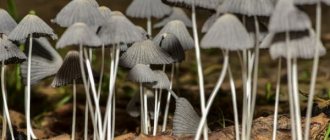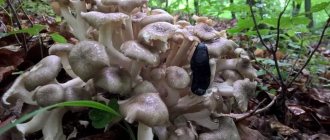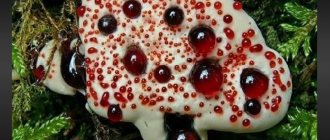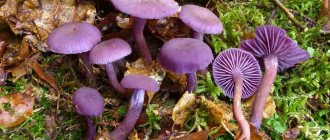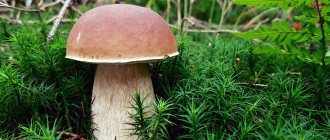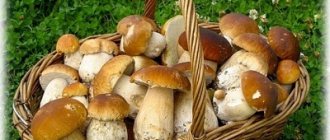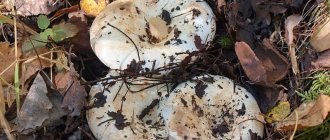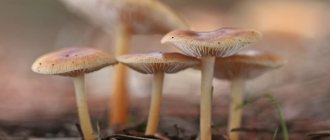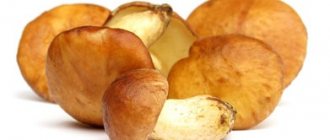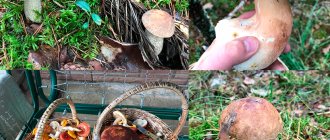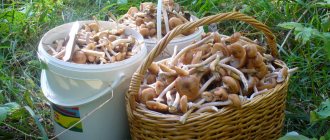Short description
| Type of mushrooms: | inedible, poisonous |
| Other names (synonyms): | Devil's hedgehog |
| Latin name: | Hydnellum peckii |
| Family: | Bankeraceae |
| Distinctive feature: | Hydnellum peckii is an inedible (though not toxic) fungus that has a very unusual appearance. |
| Beginning of the season: | July |
| End of season: | november |
| Leg height (cm): | 1-5 cm |
| Cap width (cm): | 3-9 cm |
| Smell: | sour |
| Taste: | bitter |
| Tasting score: | – |
| Hat: | cushion-shaped, convex, flat, uneven, slightly depressed in the center. The surface is felt or velvety, becoming smooth with age. Initially whitish, but later becoming slightly brownish or reddish-black. At high humidity, drops of red liquid begin to ooze on the cap, which turn brown after drying. |
| Leg: | thick, very short, often deformed, cylindrical in shape. The color is whitish, later becoming the same as that of the cap. |
| Hymenophore (bottom of cap): | spinous, whitish, later red-brown, spines up to 5 mm long and 0.2 mm wide. |
| Disputes: | round, elliptical, 5-6 x 4-4.5 microns. |
| Pulp: | pale pinkish-brown, the cap is lighter than the stem, with brownish veins. |
| Natural environment and mycorrhiza: | on the ground between mosses and in coniferous forests. |
| False doubles: | Hydnellum ferrugineum - differs in brown shades in color and mild, non-bitter taste. |
| Growing: | – |
| Use: | – |
| Medicinal properties: | – |
| Spreading: | in North America, Europe and has recently been discovered in Iran and Korea. |
Today in the forest spaces you can see a huge number of mushrooms. However, not all of them are edible; many of them are even dangerous and toxic. But nature never creates unnecessary things; even a seemingly useless and inedible species can be used for medicinal purposes. One of the brightest representatives of such mushrooms is Gidnellum Peca.
Description
Hydnellum Peck was named after the writer and explorer Charles Peck; he first described his find in the middle of the 19th century.
The mushroom cannot be completely excluded from the category of useful and edible, since it is not toxic. The main feature of hydnellum is its appearance. In Alaska and North America, local residents nicknamed it “bleeding mushroom,” and in Norway, “bloody tooth.” In Russia, this representative of the mushroom kingdom is extremely rare; only a few managed to find it on the high peaks of the Caucasus Mountains. Latin and international name - Hydnellum peckii. You can also find other nicknames:
- Killer mushroom;
- Pretty mushroom;
- Cake;
- Devil's hedgehog.
hat
The surface of the cap resembles the shape of a shell. Many experts compare it to gills or rotting fruit. This is understandable, since in adulthood the Killer Mushroom looks scary. It is very difficult to confuse the cap with other species, since during the ripening period “red juice” begins to ooze from it. Large drops on the white spongy surface indicate that the mushroom belongs to the Bankeraceae family.
Hymenophore
The hymenophore is difficult to identify, since most of the mushroom is occupied by a bright cap. However, if you look closely, a scaly formation begins on the inside of the cap. It is this that is the hymenophore. In a young mushroom it is soft, pronounced, white and has small scales. They can be compared to the bristles of the human tongue. During the ripening period, they increase in size and darken.
Pulp
The creamy pulp has a corky structure. If you cut a mushroom in half, red juice will flow out of it, which is located in small hollow holes.
Leg
Gidnellum was nicknamed “Bloody Tooth” for a reason. The name fully corresponds to the species, since the stem of the mushroom resembles the root of an adult tooth. During its entire life it barely reaches 3 cm in length. Most of it is in the soil.
Time and place of fruiting
Hydnellum grows mainly in North America and in the mountainous part of Europe. In Russia it was seen only a few times. Gidnelluma Peca chooses coniferous and rocky areas. The type of nutrition is significantly different from the usual mushrooms.
The family can take beneficial juices and minerals both from the soil and from small insects. Small midges, falling on the surface of the mushroom cap, stick to the juice and are completely absorbed by the fruiting body.
The mushroom is a late species, so it can be found during the period of fallen leaves. When the soil turns gray, Peck's Hydnellum stands out and is hard to miss. Another distinctive feature is the “reluctance” of the mycelium to reproduce, so the fruiting bodies grow singly.
External description
The fruiting body of the rusty hydnellum is cap-footed.
Hat. The diameter of the cap is 5-10 cm. In young specimens it has a club-shaped shape, in mature mushrooms it becomes obverse-cone-shaped (it can be funnel-shaped or flat in some specimens).
The surface is velvety, with many irregularities, often covered with wrinkles; in young mushrooms it is whitish in color. Gradually, the surface of the cap becomes rusty brown or pale chocolate. It clearly shows purple droplets of oozing liquid, which dries and leaves brown spots on the cap of the fruiting body.
The edges of the cap are smooth, white, becoming brown with age. The mushroom pulp is two-layered, near the surface it is felty and loose. It is best developed near the base of the leg, and in this area it has a lighter color. In the center of the cap of the rusty hydnellum, the consistency of the tissue is leathery, transversely zoned, fibrous, rusty brown or chocolate in color.
During growth, the fruiting body of the mushroom seems to “flow around” the obstacles it encounters, for example, twigs.
Characteristics of the hymenophore. The spinous hymenophore consists of spines going down slightly down the stalk. At first they are white, gradually becoming chocolate or brown. They are 3-4 mm long and very brittle.
Spikes close up:
Leg. The height of the stem of Hydnellum rust is 5 cm. It itself is completely covered with rusty-brown soft fabric and has a felt structure.
Microscopic signs. Thin-walled hyphae have slightly thickened walls, do not contain buckles, but have septa. Their diameter is 3-5 microns, there is minimal color. Near the surface of the cap you can see a large accumulation of brownish-red hyphae with blunt ends. Round warty spores are characterized by a slightly yellowish color and dimensions of 4.5-6.5 * 4.5-5.5 microns.
Chemistry
Structural formula of atromentin
Hydnellum peckii extract
revealed the presence of an effective anticoagulant called atromentin (2,5-dihydroxy-3,6-bis(4-hydroxyphenyl)-1,4-benzoquinone), and similar in biological activity to the well-known anticoagulant heparin.[36]
Atromentine also has antibacterial activity by inhibiting the enzyme enoyl acyl carrier protein reductase (essential for biosynthesis of fatty acids) in the bacteria Pneumococcus
.[37]
Hydnellum peckii
may bioaccumulate the metal cesium. In one Swedish training field, up to 9% total cesium was detected in fungal mycelia in the topmost 10 cm (3.9 in) of soil.[20] Typically, ectomycorrhizal fungi, which grow most actively in the upper organic soil horizons or at the interface between organic and mineral layers, are involved in the retention and cycling of cesium-137 in organic-rich forest soils.[38]
Description
The fruiting bodies are simple or fused, with a flattened or depressed, usually uneven, velvety-scaly cap up to 6.5 cm in diameter. The cap is painted white, and with age it becomes red-black, purple-black or brown, less often a dark blue hue, often with concentric zones.
The leg is 0.5-6×0.5-2 cm, cylindrical or fusiform, whitish, then the same color as the cap.
The hymenophore is spinous, the spines are up to 5 mm long, at first white, then darken to light lilac or brownish.
The flesh is light, pinkish-brown or light brown, darker in the stem than in the cap, with noticeable yellowish veins. The taste is bitter and strong.
It grows on the ground in autumn in coniferous (spruce and pine) forests. Inedible due to strong bitter taste.
Uses
Although the fruiting bodies of H. peckii
have been described as "Danish pastry with strawberry jam",[9] and
Hydnellum
species are not generally known to be poisonous,[34] they are not particularly edible due to their extremely bitter taste.[9] This causticity persists even in dried samples.[25]
Fruiting bodies of this and other Hydnellum
The species is prized by mushroom dyers.[35] Colors may vary from beige if not. caustic is used in varying shades of blue or green depending on the mordant added.[25]
What can a bleeding mushroom be confused with?
There are several varieties of hydnellum, which the bleeding mushroom looks like:
- Hydnellum blue. Another inedible specimen that grows mainly in the northern part of the European hemisphere. Located in coniferous forests, chooses sunny places with a large accumulation of white mosses. Usually the fruits are solitary and bear fruit from July to September. The mushroom cap can reach 20 cm in diameter, the height of the stem does not exceed 12 cm. On the uneven surface of Hydnellum blue, you can see bulges resembling tubercles. In young specimens, the cap part is slightly velvety. The name of the fruit is due to the fact that the upper part of the cap is painted in a bluish tint, and below it has a more saturated, dark color. The leg is brown in color. The pulp is dense, woody. It is characterized by neither a pronounced smell nor a noticeable taste.
- Hydnellum is odorous. Also an inedible specimen, like all previously described breeds. It has a tuberous fruiting body, which can be concave, and a velvety surface. Young mushrooms are white, but over time it becomes noticeably darker. This variety also tends to produce red droplets. They also appear through the pores that thickly cover the cap. On the lower part (where the hymenophore is usually located) you can see bluish spines. The stem of Hydnellum fragrantum has a cone-shaped shape. The spores are brown. Despite its name, this mushroom has an unpleasant odor. The fruiting period does not last very long. Mushrooms grow mainly in autumn. They settle near spruce and pine trees on sandy soil.
All varieties of hydnellum look unusual and are very attractive in appearance. You can just admire them and that’s all. It is not recommended to bring them home even as a decorative element, especially if you have small children. Even accidental ingestion of the poison contained in the mushroom juice poses a serious danger to life!
Bloody tooth mushroom - the most interesting facts about Hydnellum peca
An interesting representative of the mushroom kingdom is the Bloody Tooth mushroom, which received its name due to its unconventional appearance. They first wrote about it in 1913, although it was found much earlier (1812). But even now it remains a mystery to scientists, since it has not yet been fully explored.
Synonyms: there are many other names, some associate it with berries in sour cream - “strawberries and cream”, a mushroom on which raspberry syrup has been poured, “tooth with red juice”, and to some it resembles chewing gum with berry filling , “devil's tears”, devil's hedgehog, bleeding hedgehog, devil's tooth, tooth mushroom, tooth juice (the red-juice tooth), devil's tooth. Most often called a bleeding tooth (bleeding tooth fungus).
Appearance (description)
With its appearance, the Bleeding Tooth mushroom can greatly frighten you or, conversely, interest you, depending on what it is associated with. With their appearance, individuals not only attract people, but also attract insects, which make a wonderful “dinner”. The fruit body is whitish, velvety, but over time it becomes brownish.
Fruiting body. Its white (slightly pink) velvet cap has a bizarre shape with small depressions on which there are droplets of bright red color passing through the pores. Most people associate them with blood. With age, growths appear along the edges (much like teeth). This is where the name Bleeding Tooth comes from.
The cap is whitish-pinkish and irregular in shape, usually with a diameter of 5-7 cm (with the exception of 10 cm). As they age, the cap changes from an attractive whitish and fleshy one to a red-black and then brown plug.
The leg of this representative is very small - 2 cm (in the shape of a cone) of a whitish color (matching the color of the cap), it is almost invisible and, if you look closely, you can see how skillfully it “hid” in the moss or in the ground.
Brown spore powder is found on numerous needles on the bottom of the mushroom.
The flesh is white, but darkens with age. It's always a little darker closer to the stem.
Smell and taste. The smell is almost imperceptible, although it may seem like it smells like strawberries. The taste is bitter. There is no need to try the mushroom, as it is poisonous. Anyone who wants to test what the Hydnellum peca mushroom tastes like or its red liquid similar to raspberry or strawberry jam will die.
Growth time
It is rare to see Hydnellum peca or bleeding mushroom in our area, but it grows in the autumn months from September to November.
Where does the Bloody Tooth mushroom grow?
This mushroom can only be seen in coniferous forests. The countries with the most favorable conditions for its growth are in North America, Australia and central Europe. It is also found in the Pacific Northwest, Korea and Iran. In the CIS countries, it is extremely rare to find Bleeding Tooth, although the climate is constantly changing and therefore new species of mushrooms appear where they have never existed before, and some, on the contrary, disappear.
Hydnellum peka prefers sandy soils because they absorb moisture better. He loves “loneliness”, because of this he is found in most cases as a single specimen, although a small group can also be found.
Edibility
Hydnellum peca is an inedible poisonous mushroom. Many consider it extremely poisonous, from which you can die if you lick even one red drop. But if the toxicity of the substance in the red liquid is still being studied, then it is already known for sure that the pinkish cap contains toxic substances and is dangerous to human life.
Medicinal properties
It was once used on the farm to create a dye. It also has beneficial properties, namely antibacterial. It contains the pigment atromenthin, which is very valuable in medicine, as it can cure many people suffering from blood clots. With its help, you can easily avoid the formation of blood clots. But, unfortunately, this mushroom is not yet used in medicine, although they believe that very soon they will receive miracle drugs, just as they previously obtained the antibiotic penicillin from the fungus Penicillium notatum.
Similarities with other species
Since the bloody tooth mushroom differs from all representatives of the mushroom world due to its red liquid, it is very difficult to confuse it with other individuals. Outwardly, it may resemble milk mushrooms.
Recommendations
- ^ a b
"
Hydnellum peckii
Banker 1913."
MycoBank
. International Mycological Association. Retrieved 2010-10-04. - ^ a b c d f
Banker HJ.
(1913). "Type studies of Hydnaceae: V. Genus Hydnellum
."
Mycology
.
5
(4): 194–205. Doi:10.2307/3753385. JSTOR 3753385. - Saccardo PA, Trotter A (1925). "Supplementum universale, Pars X. Basidiomycetae". Sylloge Fungorum
(in Latin).
23
:470. - Snell WA, Dick EA, Jackson HA, Taussig M (1956). “Notes on pileate hydnums. III". Lloydia
.
19
(3): 163–75. - ^ a b c d f g gram hour
Hall D, Stuntz DE (1972).
“Pileate Hydnaceae of the Puget Sound Region III. Brown spore genus: Hydnellum
."
Mycology
.
64
(3): 560–90. Doi:10.2307/3757873. JSTOR 3757873. - Parfitt, D., Ainsworth, A. M., Simpsom, D., Rogers, G. J., Boddy, L. (2007). “Molecular and morphological discrimination of stipitate hydnoids in childbirth. Hydnellum
and
Phellodon
."
Mycological studies
.
111
(7):761–77. doi:10.1016/j.mycres.2007.05.003. PMID 17681224. - "Hydnellum peckii, Devil's Tooth, identification." www.first-nature.com
. Received 2019-12-13. - ^ a b c d
Evenson VS.
(1997). Fungi of Colorado and the Southern Rockies
. Westcliffe Publishing. paragraph 168. ISBN 978-1-56579-192-3. Retrieved 2010-01-10. - ^ a b c d
Arora, D. (1986).
Mushrooms Demystified: The Complete Guide to Fleshy Mushrooms
. Berkeley, CA: Ten Speed Press. p. 627. ISBN 978-0-89815-169-5. Retrieved 2010-01-10. - ^ a b
September JD.
(2006). Common Fungi of the Northwest: Alaska, Western Canada, and the Northwestern United States
. Sechelt, British Columbia, Canada: Calypso Publishing. p. 68. ISBN 978-0-9739819-0-2. - Barron G. (May 2002). " Hydnellum peckii
".
George Barron's mushroom website
. University of Guelph. Archived from the original on 2011-06-06. Retrieved 2010-10-05. - Phillips R. " Hydnellum peckii
".
Roger's mushrooms
. Archived from the original on December 31, 2010. Retrieved 2010-01-11. - Ellis JB, Ellis MB (1990). Gillless Mushrooms (Hymenomycetes and Gasteromycetes): An Identification Guide
. London: Chapman and Hall. paragraph 106. ISBN 978-0-412-36970-4. Retrieved 2010-01-10. - ^ a b
Orr D. B., Orr R. T. (1979).
Fungi of Western North America
. Berkeley, CA: University of California Press. paragraph 56. ISBN 978-0-520-03656-7. - Tylukti EE. (1987). Fungi of Idaho and the Pacific Northwest Vol.
2 Hymenomycetes without gills . Moscow, Idaho: University of Idaho Press. pp. 158–59. ISBN 978-0-89301-097-3. - Miller HR, Miller OK (2006). North American Mushrooms: A Field Guide to Edible and Inedible Mushrooms
. Guilford, CN: Falcon Manual. item 405. ISBN 978-0-7627-3109-1. Retrieved 2010-01-10. - Harrison K.A., Grund D.W. (1987). "Preliminary Keys to the Terrestrial Hydnas of North America." Mycotaxon
.
28
(2): 419–26. Archived from the original on 2018-10-30. Retrieved 2010-10-10. - Näsholm, T., Ekblad, A., Nordin, A., Giesler, R., Högberg, M., and Högberg, P. (1998). "Boreal forest plants take up organic nitrogen." Nature
.
392
(6679):914–16. Bibcode:1998Natura.392..914N. doi:10.1038/31921. S2CID 205001566. - Agerer, R. (1993). "Ectomycorrhiza of Hydnellum peckii
on Norway spruce and their chlamydospores."
Mycology
.
85
(1):74–83. Doi:10.2307/3760481. JSTOR 3760481. - ^ a b
Vinichuk M.M., Johanson K.J., Taylor A.F.
(2003). "137Cs in the fungal compartment of Swedish forest soils". Environmental Science in General
.
323
(1–3):243–51. Bibcode:2004ScTEn.323..243V. doi:10.1016/j.scitotenv.2003.10.009. PMID 15081731. - ^ a b
van der Linde S, Alexander IJ, Anderson IC (2009).
"Spatial distribution of sporocarps of stipitate hydnoid fungi and their underground mycelium." FEMS Microbiology Ecology
.
69
(3): 344–52. Doi:10.1111/j.1574-6941.2009.00716.x. PMID 19558589. - Cairney JWG. (2005). "Mycelium of basidiomycetes in forest soils: size, dynamics and role in nutrient distribution." Mycological studies
.
109
(1):7–20. Doi:10.1017/S0953756204001753. PMID 15736859. - van der Linde S, Alexander I, Anderson IC (2008). "PCR-based method for detection of mycelium of stipitate hydnoid fungi in soil." Journal of Microbiological Methods
.
75
(1): 40–46. doi:10.1016/j.mimet.2008.04.010. PMID 18586344. - Visser, S. (1995). "Ectomycorrhizal fungal sequence in Scots pine stands after fire." New Phytologist
.
129
(3):389–401. Doi:10.1111/j.1469-8137.1995.tb04309.x. JSTOR 2558393. - ^ a b c
Bessette A., Bessette A.R.
(2001). Rainbow Beneath My Feet: A Mushroom Dyer's Field Guide
. Syracuse: Syracuse University Press. paragraph 118. ISBN 978-0-8156-0680-2. Retrieved 2010-10-07. - Papetti C., Chiari M., Restelli V. (2006). "Notes on the mycoflora of Brescia". Bollettino del Circolo Micologico G. Carini
(in Italian).
52
: 3–8. ISSN 1122-5262. - Doll, R. (1979). "Distribution of Hydnaceae stipitata and occurrence of Hericium creolophus
,
Cirrhatus spongipellis
,
Pachyodon
and
Sistotrema confluens
in Mecklenburg, East Germany."
Repertory Feddes
(in German).
90
(1–2): 103–120. Doi:10.1002/fedr.19790900107. ISSN 0014-8962. - ^ a b
Newton A. S., Holden E., Davie L. M., Ward S. D., Fleming L. W., Watling R. (2002).
"The status and distribution of stipitate hydnoid fungi in Scottish coniferous forests." Biological conservation
.
107
(2):181–92. Doi:10.1016/S0006-3207(02)00060-5. - Gulden G, Hanssen EW (1992). "Distribution and ecology of algal stipule fungi in Norway, with particular reference to the issue of decline" (Abstract). Sommerfeltia
.
13
: 1–58. ISSN 0800-6865. Retrieved 2010-01-11. - Arnolds E. (1989). "Past and present distribution of stipitate algal fungi (Basidiomycetes) in the Netherlands". Nova Hedwigia
.
48
(1–2): 107–42. - Grouda P. (1999). "Gidna mushrooms of the Czech Republic and Slovakia." Czech mycology
.
51
(2–3): 99–155. ISSN 0009-0476. - Assef MR. (2008). " Hydnellum peckii
, a new ectomycorrhiza for Iran".
Rostanikha
.
9
(2): 115. ISSN 1608-4306. - Han SK, Oh SH, Kim HJ (2010). "Eight Unregistered Mushrooms Found at the Korean National Arboretum." Mycobiology
.
38
(2): 81–88. doi:10.4489/MYCO.2010.38.2.081. PMC 3741570. PMID 23956632. - Ammirati J, Traquair JA, Horgen PA (1985). Poisonous mushrooms of Canada
. Markham, Ontario: Fitzhenry & Whiteside in collaboration with Agriculture Canada. paragraph 18. ISBN 978-0-88902-977-4. - Arora, D. (1991). Everything the Rain Promises and More: A Pocket Guide to Western Mushrooms
. Berkeley, CA: Ten Speed Press. p. 206. ISBN 978-0-89815-388-0. Retrieved 2010-10-05. - Hannah J. M., Malone M. H., Eyler K. L., Brady L. R. (1965). "Atromentin is an anticoagulant from Hydnellum diabolus
."
Journal of Pharmaceutical Sciences
.
54
(7): 1016–20. Doi:10.1002/jps.2600540714. PMID 5862512. - Zheng CJ, Song MJ, Kim WG (2006). "Atromenthin and leucomelon, the first inhibitors specific for enoyl-ACP reductase (FabK), Pneumococcus
."
Journal of Antibiotics
.
59
(12): 808–12. Doi:10.1038/ja.2006.108. PMID 17323650. - Rühm, W., Steiner, M., Kammerer, L., Hirsche, L., Wirth, E. (1998). "Estimating future radiocaesium contamination of mushrooms based on behavioral patterns derived from a past contamination event." Journal of Environmental Radioactivity
.
39
(2): 129–47. Doi:10.1016/S0265-931X(97)00055-6.
Description of hydnellum pitch
Gidnellum peka is a mushroom belonging to the Bankeraceae family and the genus Gidnellum. The name fully corresponds to the characteristics of the specimen, since it is translated as “bleeding tooth.” This fruit was first identified and described in 1812.
What does it look like
The surface of the mushroom is abundantly strewn with red dots that look like drops of blood. But if you look closely, you will notice that this is not blood, but simply juice that oozes through the pores located in the hydnellum cap. The fruit has some similarities with the usual edible puffball, which has been previously watered with currant juice or maple syrup.
For its unusual, “bloody” appearance, the mushroom received the name “devilish hedgehog”. Also, this name may be explained by the extreme toxicity of this mushroom specimen.
Structure and features of the species hydnellum peckii
This mushroom is not similar to other species, however, its structure is the same. That is, the structure of the hydnellum is formed:
- With a hat. It has an irregular shape, with tubercles visible on its surface. This is what gives it the appearance of a human tooth. In a young specimen, the cap surface is painted white or light pink. On the top of the cap there are numerous red dots, which are balls filled with liquid. In humid weather, juice secretion occurs more intensely. On average, the diameter of the cap is 5 cm. But in exceptional cases, and only in old hydrellums, it can grow up to 10 cm in circumference. As the life cycle of the mushroom completes, its cap acquires a darker, brown color. If you turn the specimen over and look at the bottom of its cap, you can see that it is studded with small spines.
- Pulp. At first it has a dense structure, but over time it becomes like a cork. The color of the pulp is light brown or pinkish. It tastes bitter, but has no distinct odor. Although, if you study it more carefully, you get the feeling that it smells like strawberries.
- With a leg. It is very small, and is also located deep in the moss or underground. It has the same color as the cap, but is conical in shape.
As the mushroom ages, the edges of the mushroom cap acquire sharp projections, which make it look like a tooth.
Remember! Despite the attractive appearance of hydnellum, it is not edible. Moreover, the mushroom is very poisonous and can easily be poisoned. The mortality rate when consuming this specimen is almost one hundred percent! It is the drops that are located on the cap surface of the fruit that contain deadly poison.
Edible or not?
The mushroom is not eaten. Despite the fact that hydnellum is a distant relative of champignons, it cannot be eaten due to the abundant content of red juice in the body. It is this that is dangerous poison.
Scientists note that eating the mushroom is fatal. The poison is absorbed into the blood extremely quickly and it is sometimes very difficult to save the victim.
This species is being actively studied by specialists, and despite the dangerous poison, it can be used in medicine. Due to the abundance of penicillin, it may soon be used as a vaccine against known viruses that have become immune to strong drugs.
Habitat and distribution
Fruit bodies of Hydnellum peckii
found, becoming solitary, scattered or grouped together on the ground under coniferous trees, often among mosses and pine needle debris.
H. peckii
is a “late stage” fungus that, in arctic forests dominated by Banks pine, typically begins to associate with more mature hosts once the canopy has closed. A preference for mountainous or subalpine ecosystems has been noted.
The fungus has a wide distribution in North America and is especially common in the Pacific Northwest; its range extends north into Alaska and east into North Carolina. In the Puget Sound region of the US state of Washington, it is found in association with pseudohemlock, spruce and hemlock. Along the Oregon coast it was collected under lodgepole pine. In addition to North America, the fungus is widespread in Europe, and its presence has been reported in Italy, Germany and Scotland. The species is common in the latter location, but is becoming increasingly rare in several European countries, such as Norway, the Netherlands and the Czech Republic. Increased pollution in Central Europe has been suggested as one possible factor in the decline of the fungus there. Reports from Iran in 2008 and Korea in 2010 were the first outside Europe and North America.
Taxonomy, phylogeny and naming
The species was first described scientifically by American mycologist Howard James Bunker in 1913.[2] Italian Pier Andrea Saccardo placed the species in the genus Hydnum
in 1925,[3] while Walter Henry Snell and Esther Amelia Dick placed it in
Calodon
in 1956;[4]
Hydnum peckii
(Banker) Sacc.
and Calodon peckii
Snell and E. Dick synonyms of
Hydnellum peckii
.[1]
The fungus is classified as a stirrup mushroom (species believed to be descendants of a common ancestor). Devil
genus
Hydnellum
, a group of similar species with the following common characteristics: the flesh is marked by concentric lines that form alternating light and darker zones (zoning);
extremely pungent taste; sweetish smell; spores that are ellipsoid, and not amyloid (that is, not absorbing iodine when stained with Meltzer's reagent), acyanophilic (not stained with Cotton blue reagent), covered with tubercles; Presence of clamp junctions in hyphae.[5] Molecular sequence-based analysis of the internal DNA layout of several Hydnellum
species placed
H. peckii
as most closely related to
H. ferrugineum
and
H. spongiosipes
.[6] Has a brown spore print.[7]
The specific eponym is awarded to the mycologist Charles Horton Peck.[8] The fungus is known colloquially by several names, including "strawberries and cream", "bleeding tooth fungus",[9] "red juice tooth", "Peck's hydnum",[10] "bleeding tooth fungus",[11] and "devil's tooth" ".[12]
Hornbeam - description of where it grows, the toxicity of the mushroom
Hornbeam is named after the hornbeam tree near which it most often grows. But it also has other names - gray or elm boletus, gray boletus. This mushroom is so similar to boletus that mushroom pickers cannot always distinguish them.
Characteristics of appearance
The hornbeam belongs to the Boletaceae family. His family is obabok.
Young mushrooms have a hemispherical cap shape, with folded edges. At a more mature age, the cap takes on a cushion shape. The surface is slightly wrinkled and uneven. The porous layer is up to 3 cm. The skin is matte and dry, but if it rains, it immediately becomes shiny and looks watery. Therefore, in comparison with boletus, it loses due to the less high-quality density of the cap. If the mushroom is overripe, the skin completely shrinks, and then the flesh of the cap and tubes are visible underneath.
The flesh of a young specimen is usually white and soft. But the older generation of hornbeams acquires rigidity with age, which makes them significantly different from boletus. When the mushroom is cut, it darkens to a pink-purple color and then becomes dark gray. But the aroma and taste of the mushroom are pleasant.
The color of the leg is grayish, but at the bottom it changes to brownish. It has a cylindrical shape, which becomes thicker closer to the ground. The pulp in it is fibrous. The thickness of the leg is on average 4 cm, height is from 5 to 13 cm. The porous layer is free. It has a small recess located at the leg.
The shape of the spores is spindle-shaped, and the spore powder has a brown tint. The pores are very small with an angular-rounded shape, their surface is white or sandy. The tubes are narrow, have a soft consistency with a watery structure.
Where can you find a hornbeam?
Of course, where hornbeams grow, you can also find hornbeam. But since these trees belong to the birch genus, gray boletus trees are often found in birch groves. These mushrooms also grow near other deciduous trees, for example, hazel and poplar.
The most common habitats are the northern zones of Russia and Asia, the Caucasus. You can collect hornbeam as early as June, and its collection ends in October.
Hornbeam as a food product
This mushroom is classified as edible, and its taste is very similar to boletus. But due to the fact that its pulp is less dense, it cannot be stored for a long time and quickly deteriorates.
These mushrooms are especially loved by worms, so many cannot be eaten due to the fact that they are eaten away. After collecting, you should carefully sort them out at home and leave only fresh and healthy ones. If some parts are darker in color, this may be evidence of rotting, which is dangerous not only to health, but also to life.
Hornbeam is used fresh to fry and boil, dried, soaked in vinegar and salt, and pickled. To prepare various dishes, recipes that are applicable to boletus are used.
Similar mushrooms
The hornbeam has similarities (and quite a lot) with both some edible mushrooms and those that are dangerous to humans.
The gall mushroom is also a double of the hornbeam, but this is its “antipode”, as it is considered almost poisonous. It is not suitable for food because it has a bitter taste. Even if you try to remove the bitterness from him, nothing will work, it will only intensify. Such mushrooms most often grow in forests with coniferous vegetation, as well as on sandy soils. Their period of existence is from July to October. Their cap is convex, with an average diameter of 10 cm. The surface of the gall fungus is smooth and dry. The color is brown or brown. The pulp is white, thick. When it is cut, it takes on a pink tint. It has no smell, but you shouldn't try it: it is very bitter. The leg can be up to 7 cm in length, from 1 to 3 cm in width. It differs in that it is swollen and dark brown or creamy-ochre, with a mesh pattern visible.
Medicinal properties, benefits and possible harm
In North America, mushroom pickers highly value hydnellum for its bright colors. There are cases where it was specially collected in order to paint stain. However, mushroom pickers do not yet risk using hydnellum for medicinal purposes. Even in the dried form, the poison and unpleasant corpse smell remain, which repels even the largest animals.
In chemistry, hydnellum is used as an antibacterial agent. Due to the anticoagulant activity of heparin and benzoquinone, biological substances can even bioaccumulate heavy metals.
In research by Swiss scientists, up to 10% cesium was identified in this species. From a biological point of view, devil's hedgehogs have a rather complex relationship with their environment.
Despite the fact that hydnellum is called “Danish cookies,” it should not be eaten as the consequences can be very sad and it is not worth the risk.
Where does the Bloody Tooth grow, in which forests?
Hydnellum begins to bear fruit in August, and ends in late autumn. More precisely, the life cycle of the fungus ends with the onset of severe persistent frosts.
A notable feature of this specimen is the way it feeds. It not only absorbs soil juices, but also feeds on insects that land on its surface. They are attracted by the red nectar droplets of Hydnellum, which, due to their bright color, are clearly visible in the forest.
In 2012, this specimen was found in Buryatia. And the most interesting thing is that ordinary summer residents stumbled upon it and sent them to pick mushrooms in the vast surroundings of the Geologist gardening center, located in the Ivolginsky district.
Similar species
The closely related and also inedible Hydnellums are most similar to Peck's Hydnellum:
- rust (Hydnellum ferrugineum). It can be confidently distinguished at the maturity stage, when the initially light fruiting body with drops of purple liquid on the surface acquires a characteristic rich rusty-brown “tan”;
- blue (Hydnellum caeruleum) growing among white mosses in northern European forests. Also emits “bloody” droplets, but has a distinct blue color. With age, the center of the cap turns brown.
- fragrant (Hydnellum suaveolens). Light fruiting bodies with bluish spines darken with age and have a rather pungent odor. At all stages of development, no colored liquid is released.
Habitat
The fruiting bodies of Hydnellum peckii have been found to grow alone, scattered or grouped together on the ground under coniferous trees, often among mosses and pine needles.
The fungus is widespread in North America, especially in the Pacific Northwest. Its range extends north to Alaska and east to North Carolina. In the Puget Sound region of Washington State, USA, it is found in association with Douglas fir, silver fir and hemlock. Along the Oregon coast it has been found under a pine tree. In addition to North America, the fungus is widespread in Europe, with its presence documented in Italy, Germany, and Scotland. It is also found in other European countries, but much less frequently. Increasing pollution in central Europe has been suggested as one possible factor in the decline in fungal populations. Reports of the mushrooms being found from Iran in 2008 and Korea in 2010 were the first outside Europe and North America.
Ecology
Hydnellum peckii
It is a mycorrhizal fungus, and as such forms a mutualistic relationship with the roots of certain trees (called "hosts"), in which the fungus exchanges minerals and amino acids extracted from the soil for fixed carbon from the host. The underground hyphae of the fungus grow a sheath of tissue around the root of a wide range of tree species in a close association that is especially beneficial to the host (called ectomycorrhizal), as the fungus produces enzymes that mineralize organic compounds and promote the transport of nutrients to the tree.[18]
Ectomycorrhizal structures of H. peckii
are among the few in Bankeraceae that have been studied in detail.
They are characterized by a plectenchymatous mantle, a layer of tissue consisting of hyphae densely arranged in a parallel orientation, or palisade, that rarely branch or overlap. These hyphae, together with adherent particles of mineral soil, are enclosed in a gelatinous matrix. Hyphae of ectomycorrhiza can become chlamydospores, a device that helps the fungus tolerate unfavorable conditions. The chlamydospores of H. peckii
have a distinctive structure—markedly different from that of other Bankeraceae—with thick, smooth inner walls and an outer wall divided radially into warts. The most striking characteristic of ectomycorrhiza in general is the way the black outer layers of older sections are shed, creating a "carbonized appearance".[19] Most of the fungal underground biomass is concentrated near the surface,[20] most likely as “mycelial mats”—dense accumulations of ectomycorrhiza and mycelium.[21] The mycelium is also known to extend well beyond the fruiting bodies, a distance of 337 centimeters (11.1 ft).[21]
Molecular techniques have been developed to aid conservation efforts of stipitate hydnoid fungi, including H. peckii
. Although the distribution of a fungus has traditionally been determined by counting fruiting bodies, this method has a serious disadvantage in that fruiting bodies are not produced consistently every year, and the absence of fruiting bodies is not an indication of the absence of its mycelium in the soil.[22] More modern methods using polymerase chain reaction to assess the presence of fungal DNA in soil have helped alleviate problems in monitoring the presence and distribution of fungal mycelium.[23]
